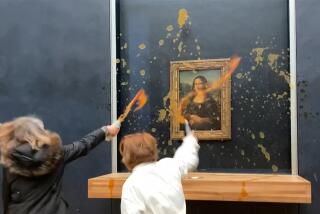Banksy pranks auction by shredding million-dollar painting. Now it may be worth even more
- Share via
Reporting from London — The U.K. street artist Banksy is no stranger to provocation. But on Friday, his antagonistic streak reached beyond his painting and into its frame.
At a London Sotheby’s auction of his 2006 spray-paint work “Girl With Balloon,” the artist rigged a secret shredding contraption into the base of the frame that destroyed the work via remote control. The painting had sold moments before for $1.4 million to an unidentified buyer, who purchased the painting via telephone.
Banksy posted video of the event on Instagram, which showed stunned auction-goers watching as an alarm sounded before the painting slipped through the frame and shredded roughly half of the canvas into ribbons.
A representative for Banksy, when reached, cited the artist’s quotation of Picasso that “the urge to destroy is also a creative urge.” A representative for Alex Branczik, Sotheby’s head of contemporary art in Europe, said he was unavailable for comment.
The painting, which was auctioned off as part of Sotheby’s “Frieze Week” contemporary art sale, had fetched more than three times its initial estimate and set a record sale price for the artist.
Banksy — whose identity still has yet to be confirmed — often incorporates political messaging, anti-capitalist ideas, and art world satire into his work.
In 2013 he even set up a pop-up stand in New York’s Central Park, where original canvases of his work were sold to customers for $60 a piece, far below the large sums his work usually demands.
In March 2005, he sneaked his own artworks into four of New York’s most prominent museums, including the American Museum of Natural History, where he left a beetle with missiles on its wings in the “Hall of Biodiversity.”
In September 2006, Banksy installed an inflatable version of a Guantanamo Bay prisoner near the Big Thunder Mountain Railroad ride in Disneyland.
His 2006 debut in America took place in a warehouse in downtown L.A., which featured a live elephant painted like wallpaper standing in a faux living room.
His new stunt, perhaps his most tangible critique of the art market yet, has instantly become the talk of the U.K. art world.
An art world disrupter
Artist Isaiah King, who is exhibiting at The Other Art Fair in London, said the event was abuzz with news of Banksy’s antics.
“I keep waiting for him to be irrelevant, and then he goes and does something like that,” King said. “If he was a lesser artist, he would have destroyed the art’s value. But because it’s Banksy it will only be worth more now.”
Dan Chrichlow, creative director of the creative management agency Dutch Uncle, had a more skeptical view. “I think the auction house knew it was going to happen. I think the whole thing was created. They check everything,” he said. “I like the fact that Banksy did it and created a whole story, which is a very Banksy thing to do. But it doesn’t feel authentic.”
It’s unclear if Sotheby’s was in on the artist’s intent to destroy the work. In a statement, the auction house said it knew the elaborate gilt frame was “an integral element of the artwork chosen by Banksy himself,” but Branczik told the Associated Press that “we have not experienced this situation in the past where a painting is spontaneously shredded, upon achieving a record for the artist…. We are busily figuring out what this means in an auction context.”
I think the auction house knew it was going to happen. I think the whole thing was created.
— Dan Chrichlow
Shepard Fairey, the popular L.A.-based street artist — most well known for his Obama “Hope” posters — said that “I do agree with the underlying sentiment of it. This is an ephemeral art form that street artists who come from the street art world understand: ‘It’s not gonna last.’ Then, ironically, there becomes a demand for it.
“I think Banksy’s idea here is that an appreciation for the concept is more important than an appreciation of the object,” he added.
Roger Gastman, the street-art expert and curator for MOCA’s popular 2011 “Art In The Streets” exhibition and this year’s “Beyond the Streets” show in Chinatown, said in an email that with this latest move, Banksy remains one of today’s preeminent art-market critics. “Banksy continues to amaze me. The king stays the king,” Gastman said.
Ron English, the New York-based street artist whose surreal work frequently comments on capitalism, said that Banksy’s antagonism toward his own work is like “Duchamp on steroids.”
“Is the work now 10 times as valuable? Or is it worth nothing?” English asked. “He’s created this really unique situation for himself.”
“Girl With Balloon,” which depicts a child reaching upward toward a heart-shaped balloon, was first stenciled on a wall in East London. It has since become one of Banksy’s most identifiable images in a career that, despite his anonymity, is meant for maximum public view.
Sotheby’s said that it was discussing how to move forward with “Balloon’s” buyer, who now owns a shredded but historically significant work by one of contemporary art’s most famous figures.
I think Banksy’s idea here is that an appreciation for the concept is more important than an appreciation of the object.
— Shepard Fairey
Becoming Banksy
Banksy began his career in the Bristol graffiti scene, tagging buildings with politically trenchant pieces critiquing police violence, Western imperialism and consumer capitalism. He frequently turns to elaborate, clandestine pranks to needle the high-end gallery and museum scene which, while making him rich, has also served as foil for his satirical work.
In 2005, he secretly hung on a wall at the British Museum a piece depicting a prehistoric human pushing a shopping cart. The work remained in the museum for several days before staff noticed it. In 2015, he built “Dismaland,” an entire theme park in an abandoned swimming resort, as a comment on British depression and entertainment culture in modern capitalism.
Orange County-based artist Jeff Gillette, whose 2010 “Dismayland” works portraying a slum surrounding the theme park were included in Banksy’s similarly titled project, calls Banksy’s newest prank “brilliant.”
“He’s Banksying the establishment,” Gillette says, “the art world, museum [world] — he’s getting at ’em.”
Though he is one of the world’s best-known contemporary artists, Banksy has always had a mixed relationship with fame, even anonymously. The 2010 documentary “Exit Through The Gift Shop” took a somewhat a jaundiced view of the booming street art scene at the time, which made global celebrities out of artists like himself and Fairey.
Fairey likens Banksy’s “Girl With Balloon” prank to performance art: ephemeral but everlasting, regardless of how the auction house ultimately proceeds regarding the work’s new buyer.
“Once he realized that media would latch on to what he was doing, he thought less about the viability of the piece for long-term exposure, [and] more about if the concept and the context was strong enough, it would live forever,” Fairey said. “He’s always thinking in a multi-layered way, and that’s part of his genius.”
He’s Banksying the establishment: the art world, museum [world] — he’s getting at ‘em.
— Jeff Gillette
Protypical pranksters
Banksy’s latest stunt has precedence in the art world. The German artist Gustav Metzger coined the genre “auto-destructive art” in the 1960s, and used the inherent ephemerality of his work as a commentary on the post-World War II collapse of the geopolitical order.
English cited Robert Rauschenberg’s “Erased De Kooning Drawing” — where the artist bought and obliterated the work of a peer — as somewhat of a precedent for Banksy’s actions.
But Scott Hove, a California artist who collaborated with Banksy on his “Dismaland” installation, said Banksy broke new ground in demolishing his own work at auction with no advance warning.
“He really ramped it up in a spectacular way. People were aghast,” Hove said. “It’s a moment of clarity to see someone devalue something worth millions. It’s kind of refreshing to see this destruction of contrived value.”
However, he also expected that, given all the media attention on the Sotheby’s stunt, Banksy probably only added to the shredded piece’s allure.
“If I were the buyer, I’d probably have been shocked, then I’d want to preserve it exactly as it is,” Hove said. “Ironically, this will only escalate its value.”
Staff writer Deborah Vankin in Los Angeles and special correspondent Christina Boyle in London contributed to this story.
More to Read
The biggest entertainment stories
Get our big stories about Hollywood, film, television, music, arts, culture and more right in your inbox as soon as they publish.
You may occasionally receive promotional content from the Los Angeles Times.











